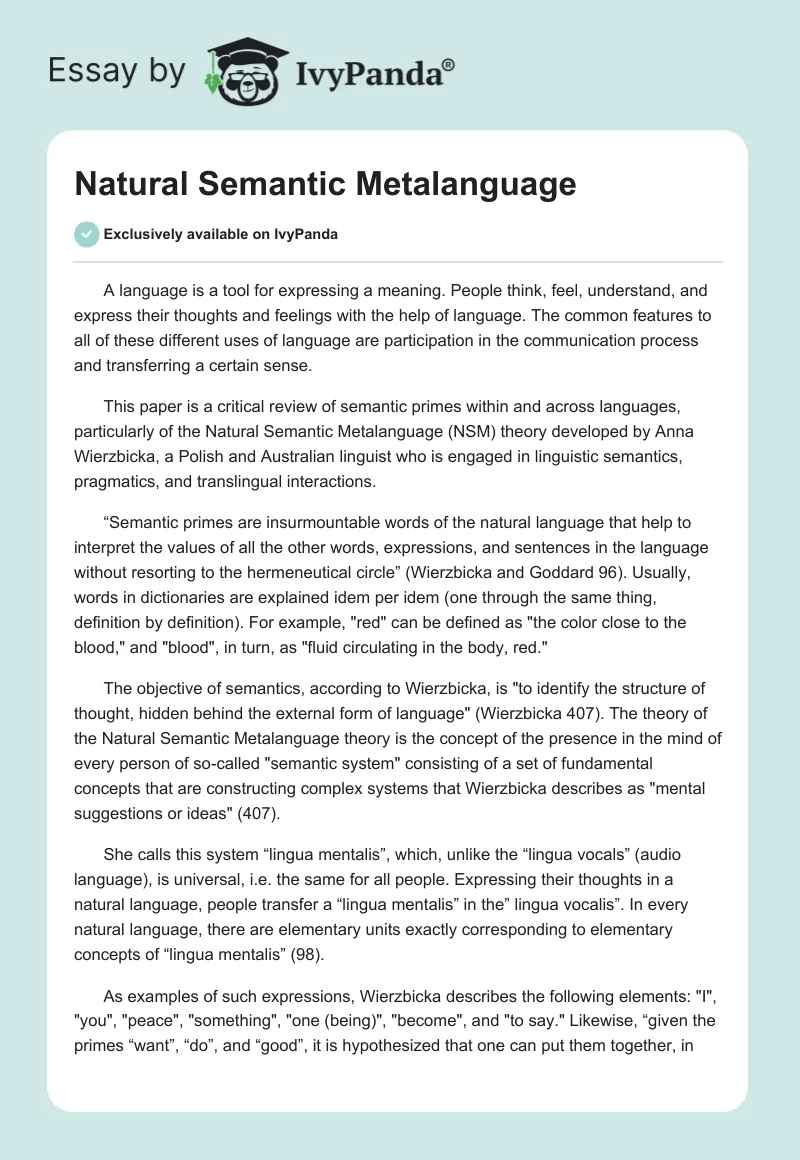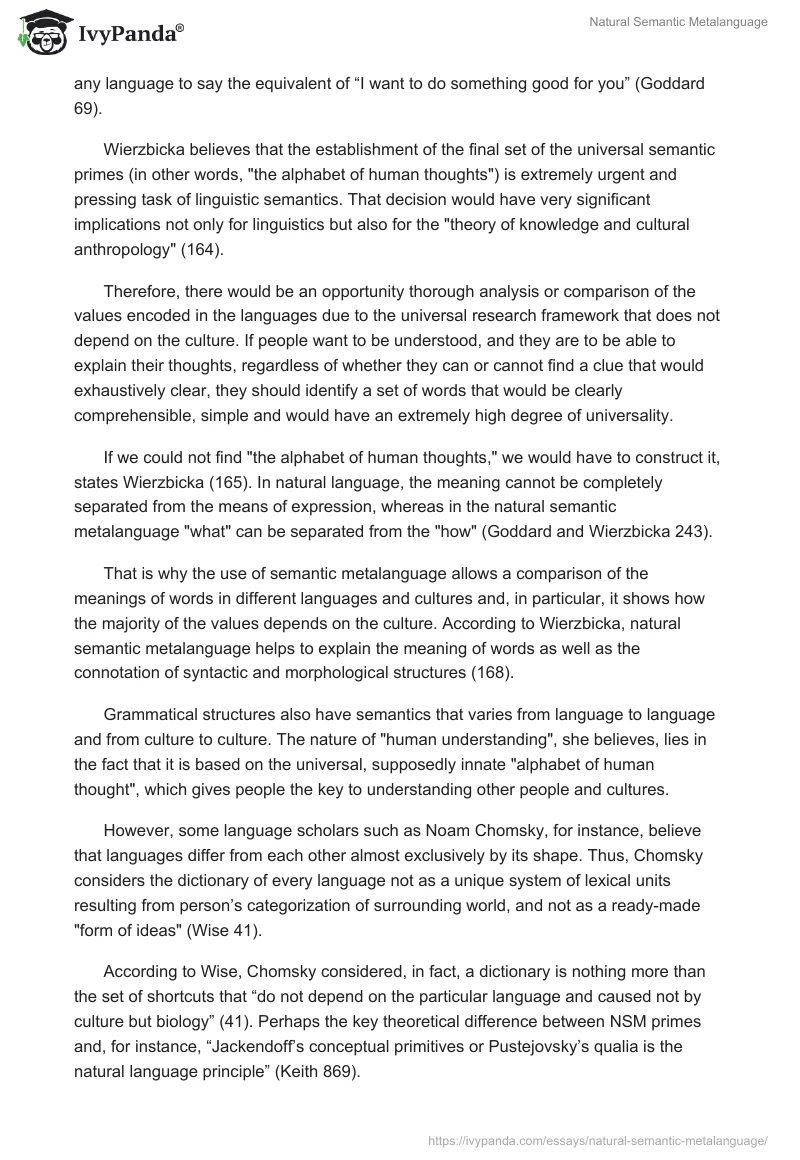A language is a tool for expressing a meaning. People think, feel, understand, and express their thoughts and feelings with the help of language. The common features to all of these different uses of language are participation in the communication process and transferring a certain sense.
This paper is a critical review of semantic primes within and across languages, particularly of the Natural Semantic Metalanguage (NSM) theory developed by Anna Wierzbicka, a Polish and Australian linguist who is engaged in linguistic semantics, pragmatics, and translingual interactions.
“Semantic primes are insurmountable words of the natural language that help to interpret the values of all the other words, expressions, and sentences in the language without resorting to the hermeneutical circle” (Wierzbicka and Goddard 96). Usually, words in dictionaries are explained idem per idem (one through the same thing, definition by definition). For example, “red” can be defined as “the color close to the blood,” and “blood”, in turn, as “fluid circulating in the body, red.”
The objective of semantics, according to Wierzbicka, is “to identify the structure of thought, hidden behind the external form of language” (Wierzbicka 407). The theory of the Natural Semantic Metalanguage theory is the concept of the presence in the mind of every person of so-called “semantic system” consisting of a set of fundamental concepts that are constructing complex systems that Wierzbicka describes as “mental suggestions or ideas” (407).
She calls this system “lingua mentalis”, which, unlike the “lingua vocals” (audio language), is universal, i.e. the same for all people. Expressing their thoughts in a natural language, people transfer a “lingua mentalis” in the” lingua vocalis”. In every natural language, there are elementary units exactly corresponding to elementary concepts of “lingua mentalis” (98).
As examples of such expressions, Wierzbicka describes the following elements: “I”, “you”, “peace”, “something”, “one (being)”, “become”, and “to say.” Likewise, “given the primes “want”, “do”, and “good”, it is hypothesized that one can put them together, in any language to say the equivalent of “I want to do something good for you” (Goddard 69).
Wierzbicka believes that the establishment of the final set of the universal semantic primes (in other words, “the alphabet of human thoughts”) is extremely urgent and pressing task of linguistic semantics. That decision would have very significant implications not only for linguistics but also for the “theory of knowledge and cultural anthropology” (164).
Therefore, there would be an opportunity thorough analysis or comparison of the values encoded in the languages due to the universal research framework that does not depend on the culture. If people want to be understood, and they are to be able to explain their thoughts, regardless of whether they can or cannot find a clue that would exhaustively clear, they should identify a set of words that would be clearly comprehensible, simple and would have an extremely high degree of universality.
If we could not find “the alphabet of human thoughts,” we would have to construct it, states Wierzbicka (165). In natural language, the meaning cannot be completely separated from the means of expression, whereas in the natural semantic metalanguage “what” can be separated from the “how” (Goddard and Wierzbicka 243).
That is why the use of semantic metalanguage allows a comparison of the meanings of words in different languages and cultures and, in particular, it shows how the majority of the values depends on the culture. According to Wierzbicka, natural semantic metalanguage helps to explain the meaning of words as well as the connotation of syntactic and morphological structures (168).
Grammatical structures also have semantics that varies from language to language and from culture to culture. The nature of “human understanding”, she believes, lies in the fact that it is based on the universal, supposedly innate “alphabet of human thought”, which gives people the key to understanding other people and cultures.
However, some language scholars such as Noam Chomsky, for instance, believe that languages differ from each other almost exclusively by its shape. Thus, Chomsky considers the dictionary of every language not as a unique system of lexical units resulting from person’s categorization of surrounding world, and not as a ready-made “form of ideas” (Wise 41).
According to Wise, Chomsky considered, in fact, a dictionary is nothing more than the set of shortcuts that “do not depend on the particular language and caused not by culture but biology” (41). Perhaps the key theoretical difference between NSM primes and, for instance, “Jackendoff’s conceptual primitives or Pustejovsky’s qualia is the natural language principle” (Keith 869).
Additionally, Willems et al. (2003) discuss that semantic primes are to improve precision in contrastive studies, essentially “because they provide a stable “tertium comparationis” in terms of which one can investigate lexical and grammatical typology.
In conclusion, it should be noted that this critical review has evaluated the semantic primes within and across languages by Willems et al. (2003). The linguistic theories presented in the chapter are very interesting, and the authors did a good job of illustrating these theories with proved data from relevant sources.
Works Cited
Goddard, Cliff. Semantic Analysis: A Practical Introduction. 2nd ed. Oxford: Oxford UP, 2011. Print.
Goddard, Cliff, and Anna Wierzbicka. Words and Meanings: Lexical Semantics Across Domains, Languages, and Cultures, Oxford, England: Oxford UP, 2014. Print.
Keith, Allan. Concise Encyclopedia of Semantics, Boston: Elsevier, 2009. Print.
Wierzbicka, Anna. Experience, Evidence, and Sense: The Hidden Cultural Legacy of English, Oxford, England: Oxford UP, 2010. Print.
Willems, Dominique, Bart Defrancq, Timothy Colleman, and Dirk Noël.Contrastive Analysis in Language: Identifying Linguistic Units of Comparison, Basingstoke, Hampshire: Palgrave Macmillan, 2003. Print.
Wise, Christopher. Chomsky and Deconstruction: The Politics of Unconscious Knowledge, New York: Palgrave Macmillan, 2011. Print.


